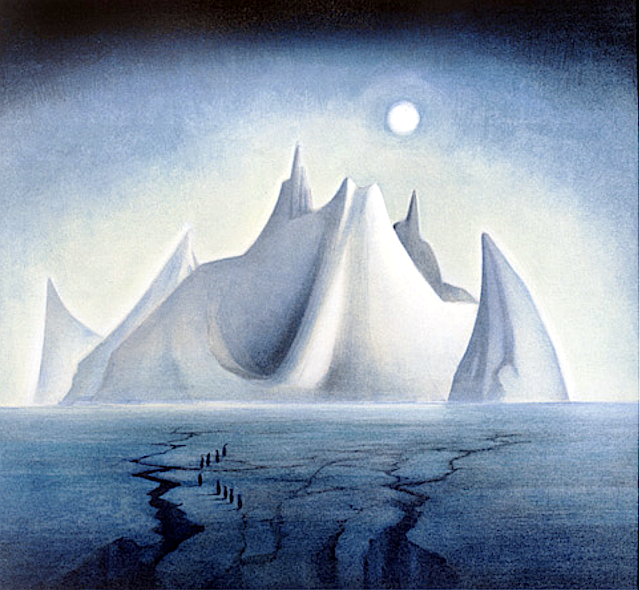The Grindelwald Glacier (1, 349 m - 4, 425m)
Switzerland (Bernese Alps)
In The Grindelwald Glacier, oil on canvas 1838, 194 x 157 cm, Nasjonalmuseet, Oslo
About the painting
In
The Grindelwaldgletscher, the highlight of Thomas Fearnley’s Swiss
landscape paintings, the viewer gazes up from the grassy knoll in the
foreground toward the bottom of a valley filled by a glacier. The
majestic composition is based on Fearnley’s on-site observations. A
sketch in pencil from August 1835 reveals a barren landscape in front of
the glacier. The large trees, which form such an essential part of the
picture’s overall composition, stem from studies of trees Fearnley made a
week later in Scheideck. Fearnley has made the landscape more
overpowering than in the original on-site drawing. The mountainsides are
steeper and have been accentuated through light and shadow. The
contrast to the everlasting ice and snow of the desolate valley is
heightened by the lush vegetation in the foreground, where sheep graze
under a shepherd’s supervision. Fearnley emphasizes the wild,
inaccessible aspects of nature by letting a bird of prey glide above the
glacier, even as he playfully includes a visual, English-based pun on
his name by adding a tuft of fern next to his signature.
Scholars
have noted how the composition and the balancing of the various
landscape elements evoke the Düsseldorf painter Johann Wilhelm Schirmer
(1807–63), whom Fearnley met during his sojourn in Switzerland. In
romanticism, a pronounced contrast between warm and cold tones, as seen
here, was also perceived as symbolizing the confrontation between life
and death. Before the painting was completed, it was shown at the Paris
Salon in 1836. Along with two paintings by J. C. Dahl, this painting and
Fearnley’s The Labro Falls at Kongsberg (1837) were the first paintings
by Norwegians artists to be acquired by the National Gallery.
The glacier
The
Lower Grindelwald Glacier also
known as the Lower Grindelwald Glacier is a glacier in the Bernese
Alps, located southeast of Grindelwald, in the canton of Bern (Swiss).
It originates under the Agassizhorn and the Strahlegghorn and is
connected to the Unteraar glacier via the Finsteraarjoch (3,283 m). The
Lower Grindelwald Glacier should not be confused with the Upper
Grindelwald Glacier, located to the northeast. The Lower Grindelwald
Glacier still has a major tributary, the Ischmeer (“sea of ice” in
Swiss German, formerly known as the “Grielwald-Fiescher Glacier”,
German: Grindelwald-Fieschergletscher3), which is the glacier overlooked
by the Eismeer station of the Jungfrau Railway.
The Lower
Grindelwald Glacier was 8.3 km long and covered an area of 20.8 km2 in
1973. It has shrunk considerably since, being only 6.2 km long in 2015,
the 1.9 km retreat being mainly intervened since 2007. In the
middle of the 19th century, the glacier reached the valley of
Grindelwald as far as Mettenberg, at an altitude of 983 m, near the
confluence of the white Lütschine and the black Lütschine. In 1900 it
still extended to the Rotenflue (1,200 m) and filled the whole valley
from its present end, the glacial lake, with a thickness of about 300 m
up to an altitude of 1,700 m, just below the current hiking trail around
the Bänisegg. In the early 2000s, it had retreated to the gorge between
the Hörnli (Eiger) ridge and the Mättenberg.
The painter
Thomas
Fearnley attended National Cadet Corps from 1814 to 1819. He was a
student of the Norwegian National Academy of Craft and Art Industry
(1819–1821), Art Academy in Copenhagen (1821–1823) and the Art Academy
(n Stockholm (1823–27) under Carl Johan Fahlcrantz. Fearnley left
Copenhagen bound for Stockholm in the autumn of 1823 to complete a
painting commissioned by Crown Prince Oscar of Norway and Sweden. He
received several orders from the Swedish royal family and from other
members of the royal court including Swedish Count Gustaf Trolle-Bonde.
He conducted study tours in Norway (1824-1826), at which time he met
Johan Christian Dahl in Sogn. After another stay in Copenhagen from 1827
to 1828 and a new Norwegian trip in the autumn of 1828, he went to
Germany and was a student of Dahl in Dresden (1829–1830) as well as
befriending the German painter Joseph Petzl and the German-Danish
painter Friedrich Bernhard Westphal. He lived in Munich (1830–32).
Fearnley traveled extensively in the 1830s, visiting Munich, Paris,
London, Hull and the English Lake district. During September 1832, he
went from Venice to Rome and visited Sicily the following summer. He
mostly painted in small towns south of Naples: Castellammare, Amalfi,
Sorrento, Capri and in Switzerland: Meiringen, Grindelwald. He went to
Paris in the summer of 1835 and visited London the next year. During the
summer of 1839 he was on a study tour to the Sognefjord and
Hardangerfjord, together with the German painter Andreas Achenbach.
Fearnley's paintings alternate between oil sketches and larger, composed
landscapes meant for exhibition. His large studio compositions have a
cool monumental attitude with a taste for the powerful and wildly
romantic in the favorite motifs, wilderness and waterfalls, and with a
strong emphasis on the image's architectural structure. The National
Gallery in Oslo owns a total of 54 of his smaller pictures and sketches
and also a series of drawings. Notable works in this collection include
Labrofossen (1837), Grindelwaldgletsjeren (1838) and Slinde Birken
(1839). Other notable collections are located in the Bergen Kunstmuseum
and the Nationalmuseum in Stockholm.
___________________________________________
2022 - Wandering Vertexes...
by Francis Rousseau















%20%20Northern%20Lights.%20Study%20from%20North%20Norway%20(c.%201901-09)%20Oil%20on%20canvas,%2046%20x%2055%20cm.%20%20Nationalmuseum,%20Stockholm.jpg)